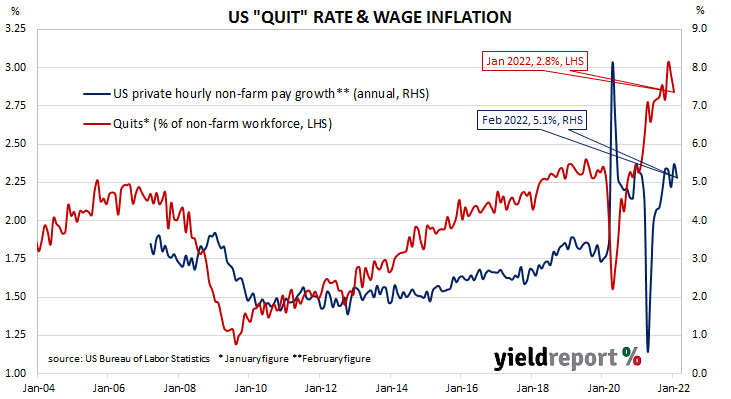Summary: US quit rate falls back to 2.8% in January; “still very high”, labour supply/demand mismatch “far from resolved”; quits, job openings down, separations up.
The number of US employees who quit their jobs as a percentage of total employment increased slowly but steadily after the GFC. It peaked in March 2019 and then tracked sideways until virus containment measures were introduced in March 2020. The quit rate then plummeted as alternative employment opportunities rapidly dried up. Following the easing of US pandemic restrictions, it proceeded to recover back to its pre-pandemic rate in the third quarter of 2020 before trending higher through 2021.
Figures released as part of the most recent Job Openings and Labor Turnover Survey (JOLTS) report show the quit rate fell again in January. 2.8% of the non-farm workforce left their jobs voluntarily, down from December’s revised figure of 3.0%. There were 151,000 fewer quits during the month and an additional 481,000 people employed in the non-farm sector.
ANZ economist Daniel Been noted the quit rate “is still very high” even after the decline. ”Given that the US labour market has continued to tighten, with unemployment down to 3.8% in February, it’s clear the mismatch between labour supply and demand is far from being resolved.”
US Treasury yields moved materially higher in what could be called a “risk-on” day. By the close of business, the 2-year Treasury bond yield had gained 6bps to 1.67%, the 10-year yield had added 9bps to 1.94% while the 30-year yield finished 8bps higher at 2.31%.
In terms of US Fed policy, expectations for a higher federal funds rate over the next 12 months softened slightly. At the close of business, March contracts implied an effective federal funds rate of 0.215%, 14bps higher than the current spot rate. June contracts implied 0.835% and March 2023 futures contracts implied an effective federal funds rate of 1.87%, 179bps above the spot rate.
The fall in total quits was led by 69,000 fewer resignations in the “Retail” sector and 63,000 fewer resignations in the “Professional and business services” sector. The “Finance and insurance” sector experienced the single largest increase, rising by 30,000. Overall, the total number of quits for the month fell from December’s revised figure of 4.403 million to 4.252 million.
Total vacancies at the end of January decreased by 185,000, or 1.6%, from December’s revised figure of 11.448 million to 11.263 million. The fall was driven by a 288,000 drop in the “Accommodation and food services” sector and a 132,000 decrease in the “Transportation, warehousing, and utilities” sector. The “Other services” sector experienced the single largest increase, rising by 136,000. Overall, 8 out of 18 sectors experienced fewer job openings than in the previous month.
In contrast, total separations increased by 16,000, or 0.3%, from December’s revised figure of 6.042 million to 6.058 million. The rise was led by the “Finance and insurance” sector, where there were 28,000 more separations than in December. Separations increased in 12 out of 18 sectors.
The “quit” rate time series produced by the JOLTS report is a leading indicator of US hourly pay. As wages account for around 55% of a product’s or service’s price in the US, wage inflation and overall inflation rates tend to be closely related. Former Federal Reserve chief and current Treasury Secretary Janet Yellen was known to pay close attention to it.


